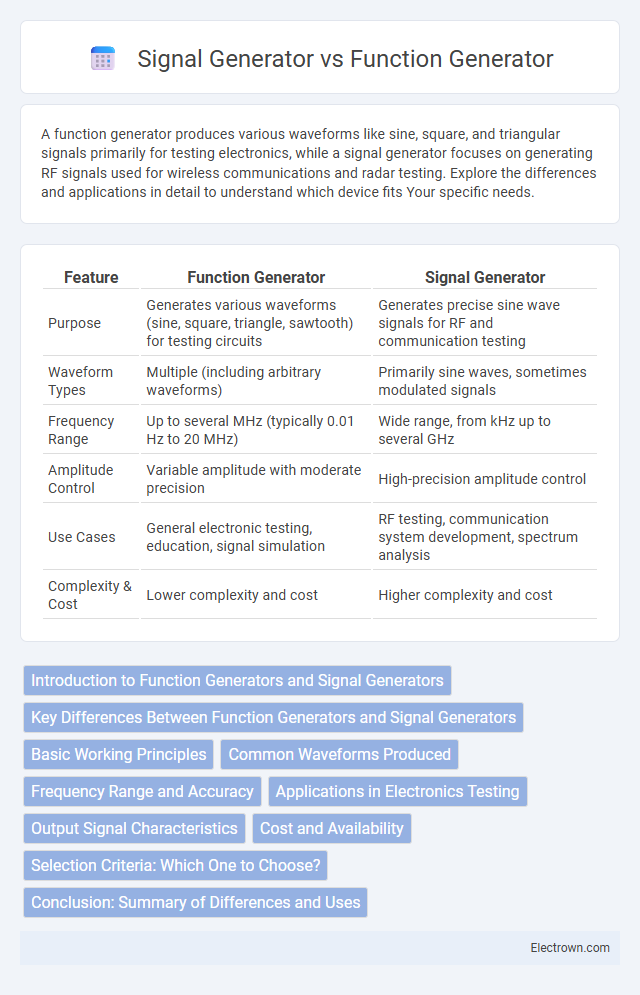A function generator produces various waveforms like sine, square, and triangular signals primarily for testing electronics, while a signal generator focuses on generating RF signals used for wireless communications and radar testing. Explore the differences and applications in detail to understand which device fits Your specific needs.
Table of Comparison
| Feature | Function Generator | Signal Generator |
|---|---|---|
| Purpose | Generates various waveforms (sine, square, triangle, sawtooth) for testing circuits | Generates precise sine wave signals for RF and communication testing |
| Waveform Types | Multiple (including arbitrary waveforms) | Primarily sine waves, sometimes modulated signals |
| Frequency Range | Up to several MHz (typically 0.01 Hz to 20 MHz) | Wide range, from kHz up to several GHz |
| Amplitude Control | Variable amplitude with moderate precision | High-precision amplitude control |
| Use Cases | General electronic testing, education, signal simulation | RF testing, communication system development, spectrum analysis |
| Complexity & Cost | Lower complexity and cost | Higher complexity and cost |
Introduction to Function Generators and Signal Generators
Function generators produce various waveforms such as sine, square, and triangle signals, ideal for testing and troubleshooting electronic circuits. Signal generators primarily create precise, stable sine waves for RF testing and communication systems. Understanding your measurement needs helps determine whether a function generator or signal generator suits your application best.
Key Differences Between Function Generators and Signal Generators
Function generators produce various waveforms such as sine, square, triangle, and sawtooth signals, primarily used for testing and troubleshooting in electronic circuits. Signal generators typically generate a single specific type of waveform, often sine waves, at precise frequencies and amplitudes for calibration and communication purposes. Key differences include waveform variety, frequency range, and typical applications, with function generators offering versatility and signal generators providing high precision and stability.
Basic Working Principles
Function generators produce repetitive waveforms such as sine, square, and triangular waves through electronic oscillator circuits, enabling the testing of electronic devices with variable frequencies. Signal generators encompass a broader category, generating both analog and digital signals, including modulated RF signals, by using complex circuitry for varying waveform, amplitude, and frequency. The fundamental difference lies in function generators primarily creating simple, precise waveforms, while signal generators offer versatile signal types for advanced testing and communication system simulation.
Common Waveforms Produced
Function generators primarily produce standard waveforms such as sine, square, triangle, and sawtooth waves, essential for testing electronic circuits. Signal generators offer a broader spectrum, including modulated signals like AM, FM, and phase modulation, used extensively in communication system development. Both devices generate waveforms crucial for analysis, but signal generators provide more complex and customizable signal types.
Frequency Range and Accuracy
Function generators typically offer a frequency range from a few hertz up to several megahertz, providing moderate accuracy suitable for general waveform testing. Signal generators, especially RF or microwave signal generators, cover a much broader frequency spectrum often extending into gigahertz with higher precision and stability critical for communication system applications. Accuracy in signal generators is enhanced by features such as low phase noise and fine frequency resolution, making them ideal for demanding frequency synthesis and modulation tasks.
Applications in Electronics Testing
Function generators primarily provide standard waveforms such as sine, square, and triangle waves, making them ideal for testing audio circuits, troubleshooting analog devices, and simulating sensor outputs in electronics testing. Signal generators offer a broader range of signal types, including modulated radio frequency signals, which are essential for testing communication devices, radar systems, and advanced RF circuits. Both tools are crucial in laboratories and manufacturing environments for validating circuit responses, calibrating equipment, and diagnosing faults in diverse electronic components.
Output Signal Characteristics
Function generators produce standard waveforms such as sine, square, triangle, and sawtooth with adjustable frequency and amplitude, ideal for testing and troubleshooting circuits. Signal generators offer more complex and customizable signals, including modulated waveforms like AM, FM, and digital patterns, crucial for communication system testing. The output signal fidelity and versatility differentiate signal generators from the simpler, more accessible outputs of function generators.
Cost and Availability
Function generators typically cost less and are more widely available than signal generators, making them an economical choice for basic waveform generation in educational and hobbyist applications. Signal generators often offer more advanced features and higher precision, reflecting in their higher price and specialized availability through professional electronics suppliers. Understanding Your specific needs helps in choosing between the affordability of function generators and the advanced capabilities of signal generators.
Selection Criteria: Which One to Choose?
Function generators produce standard waveforms like sine, square, and triangle waves, making them ideal for basic circuit testing and educational use. Signal generators offer a broader range of frequencies and modulations, suitable for advanced communication system design and RF testing. Choose a function generator for simplicity and cost-effectiveness, or a signal generator when precision, frequency range, and modulation variety are critical.
Conclusion: Summary of Differences and Uses
Function generators produce repetitive waveforms such as sine, square, and triangle waves primarily for testing and troubleshooting electronic circuits, while signal generators offer a broader range of signals including modulated and arbitrary waveforms for advanced applications like communication system testing. Function generators are generally simpler, cost-effective tools ideal for basic laboratory use, whereas signal generators provide higher precision and versatility required in professional RF and audio testing environments. Understanding the specific waveform types, frequency ranges, and modulation capabilities aids in selecting the appropriate device for targeted electronic testing tasks.
function generator vs signal generator Infographic

 electrown.com
electrown.com